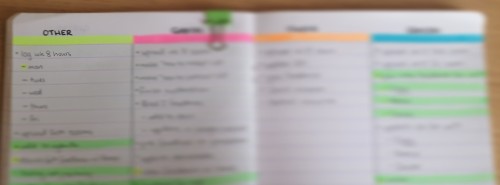
Firstly, I want to make it clear that I don’t think it’s healthy to believe that we can be more productive or more creative during a global pandemic. People are really underestimating the emotional and mental toll that living through a pandemic, civil rights movement and global climate crisis has. I think we are going to see a lot of people burn out because of all of this and I’m really trying to be mindful of that myself.
I have been working as a lecturer through this pandemic and, hoo boy, it’s been more work than usual. We had a very quick pivot to online learning that coincided with a reduction in hours and pay. I also became the NTEU union delegate for my state, which has resulted in a lot of extra work and meetings with everything going on. On top of all of that, I still organise the meetups for Squiggly River and am on the board for Making Space.
All of this is to say that I have been doing more in less time and the way I organise my time has completely changed. So I wanted to cover the time management systems that I am currently using and how effective they have been:
Analogue task tracking

In the past, I have used a mix of digital and analogue task tracking but have gone fully analogue since working from home. I do this through two notebooks that I keep open on my desk at all times (one for personal work and one for lecturing). At the start of each week, I rule up the notebook into 4 columns and give each column a category and a colour. Each column is basically a big to-do lists for all the tasks that need to be done for that week. The categories change often but I always have a “general” or “other” category. Tasks are added in any order to the lists, with much larger tasks being broken up into smaller steps and nested accordingly. Tasks that are due on or by specific days have the day of the week appended to them. Tasks are prioritised by highlighting the bullet point and marked off by highlighting the row. I add tasks to the lists as needed throughout the week. Towards the end of the week, I rule up next week’s pages, add in any known tasks and start migrating over any tasks that didn’t get completed.
Strengths
- All my tasks are available at a glance, even while I am using my computer.
- There is no barrier to adding in tasks which makes it much quicker and easier than digital task tracking.
- Splitting my tasks into separate columns allows me to see which category has the most tasks, which helps with both balancing my time and planning my week.
- Just like using a Bullet Journal, having to manually redo my task list each week forces me to see all the tasks that weren’t completed and assess the importance of them.
- Having a completely separate notebook for paid work allows me to just put it away during the weekend. I found that using digital apps (even with two separate accounts) made it too easy for me to work out of hours.
- It’s super satisfying to tick off tasks on a physical list, which really encourages me to get everything done.
Weaknesses
- This process will not be feasible when I return to work as carrying around several notebooks just isn’t possible.
- These task lists can’t be easily shared with others.
- There are no reminders, so I have to either remember what is due when or check every day.
- Recurring tasks have to be manually rewritten each week.
- Having everything visible at once means that it’s sometimes easy to get overwhelmed or distracted by lower priority tasks.
- There is no time estimation or tracking. I try to eyeball how long tasks will take when I am prioritising for the day but I’m not keeping track of anything so I don’t have data to learn from.
- Having only 4 categories is pretty limiting and doesn’t always suit the work. Additionally, sometimes tasks will come up mid-week that don’t suit any of the categories.
- There is currently no future or long-term list, so tasks that won’t be due for several weeks are either forgotten about or hastily rewritten each week.
Prioritising at the end of a day
At the end of each work day or session, the very last thing I do is prioritise my tasks for the next day. I start with prioritising any tasks that I know are due the next day, then I check my schedule to see what else I should focus on. I try to only prioritise 3 major tasks that, if completed, would make for a productive day.
Strengths
- Starting with your tasks already prioritised means that there’s no road blocks to starting and I can jump straight in.
- I’m always the most productive at the start of a day or work session, so this helps me get the most work done.
- Only prioritising 3 major tasks helps to keep me focused and prevents me from being overwhelmed by choice.
Weaknesses
- Doesn’t account for changes in schedules, projects etc. and can leave me focusing on something which is now a lower priority.
- As mentioned early, because the tasks don’t have time estimations I have to just eyeball it and prioritise tasks that should be feasible to complete together.
- In order to work out my priorities, I usually have to mentally plan tasks for the rest of the week. I don’t end up writing any of this down, so it feels wasted planning.
Scheduling via Google Calendar
For scheduling, I use Google Calendar to block in time for work, meetings and social events. Since I have Google Calendar on my phone, I just add in events as I hear about them. As mentioned above, I give each task category a colour and I use the same colours for my calendar (eg. Squiggly River tasks might be green so I make sure the events are green as well). For recurring events, I use the recurring options and for anything that needs prep or travel time I adjust the notifications. For my work day, I also schedule in my breaks so I don’t forget about them.
Strengths
- Since so many people are already using Google Calendar, it’s just convenient to have and means I can accept an invite and have it added to my calendar in a single click.
- The Google Calendar notifications are fantastic and really customisable, which makes it hard to miss an event.
- Colour coding events makes it quick to see what the day will be like at a glance.
Weaknesses
- Given that’s it’s digital, it can be easy to forget completely about events and rely solely on notifications.
Closing Thoughts and Next Steps
My current time management systems feel quick and lightweight, which is exactly what I need right now, but it’s definitely not perfect. I’m losing time each week from re-writing, re-planning and re-prioritising. Again, I don’t mind this right now but it might not be viable in busier times.
In terms of digital alternatives (for when I can’t just have 2 notebooks on me), Microsoft To Do seems to be the best solution. It allows for multiple different lists and also has options for recurring tasks and reminders. For prioritisation, it was a “My Day” list. You can add any task to this list and it will automatically include anything due on that day. I’m already using To Do for a grocery list and it’s shared lists work great. Again, I won’t be switching to To Do just yet but I will look to using it once I am no longer working from home.
Lastly, I am also planning to buy this Timeblock Planner. Timeblocking has been quite effective for me in the past and I would like to give it a go again. I don’t feel like it would be something that I would use everyday but it would be useful for extra busy weeks. I imagine that we will be having some of those in the near future…
The process of writing this has been very useful for me so I will keep you updated on any big changes I make.